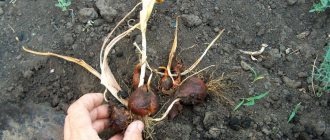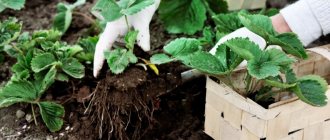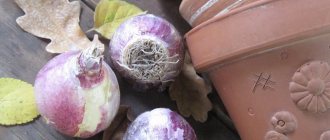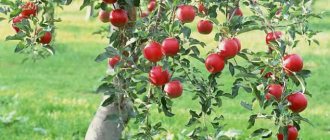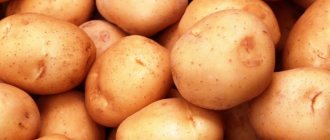When is it time to dig up celery roots?
Root celery is a short-day plant with a long growing season (120–150 days). It is on cool autumn days that the vegetable begins to actively grow and accumulate nutrients. In hot summer weather the crop hardly grows.
Deadlines
It is important to harvest root crops in time in order to prepare them for transportation and storage. They must ripen well, otherwise they will be tasteless and quickly become unusable. Due to the delicate peel, the root crop is prone to withering and rotting.
The vegetable is resistant to cold and even slight frosts on the surface, so do not rush to harvest. It is usually harvested in the second half of October.
Late varieties of root celery actively gain weight, taste, accumulate nutrients, and form a peel in October and early November. At the same time, you should not delay the event until real frosts, since the taste of frozen vegetables changes greatly.
Advice! If the celery is caught in frost before harvesting, it is not immediately brought into a warm place, but left at a positive but low temperature, no higher than +10°C, so that it does not rot.
Experienced gardeners recommend harvesting celery after a good rain. If the weather is dry, the beds are watered. Then, when digging up root crops, it will be possible to avoid their damage, which will affect the keeping quality.
By what signs can you understand that it is ripe?
The color of the tops will help determine the degree of maturity of root crops. If it starts to turn yellow and dry out, it means the celery has stopped growing and it’s time to dig it up.
Recommended timing by the manufacturer
You can determine the harvest time of a vegetable based on the information contained in the seed packaging. On the bag you can find official information about how many days should pass from the moment of germination until the root crops fully ripen. This indicator ranges from 90 to 160 days (depending on the varietal of the vegetable crop).
However, you should not rely only on information from the celery seed manufacturer. When determining the harvest date, adjustments must be made taking into account actual weather conditions.
Late root celery must be removed from the beds after night frosts have established. You should not immediately bring them from cold to warm. This will negatively affect the keeping quality of root crops.
- Author: Zimina Tatyana
Rate this article:
- 5
- 4
- 3
- 2
- 1
(2 votes, average: 5 out of 5)
Share with your friends!
Ripening dates in different regions of Russia
The timing of ripening and harvesting of root crops largely depends on the weather conditions of areas located in different climatic zones of Russia, and the varietal characteristics of the crop. It is important to plant a plant that will have time to ripen, and the harvest will be stored for a long time.
When to harvest celery in different regions of Russia:
- The Moscow region is characterized by clearly defined seasonality, high humidity, warm summers, moderately cold winters with stable snow cover and thaw. For these places, mid-early varieties of the crop are chosen, the ripening period of which is 140–150 days. Harvest occurs at the beginning of October.
- The Volga region is characterized by frosts in early spring and late autumn, snowy winters and hot summers, so it is better to plant early and medium varieties here. The harvesting period for celery in this region is September – October.
- For northern regions (Urals and Siberia) with a cold climate and frosty winters, early varieties are chosen for planting, and the harvest is harvested before mid-September.
- In the Krasnodar and Stavropol territories, where the southern climate is warm, varieties of late ripening (about 200 days) are grown. Root crops are dug up at the end of October.
Heat treatment and canning
How to store celery root in a city apartment where there is no cellar or basement? There are several ways:
Freezing
If the question arises of how to prepare celery and how to store it at home, we recommend the easiest way - frozen:
- Peel the root vegetable.
- Cut into strips, thin slices or chop on a coarse grater.
- Then place in the freezer.
You can freeze it in plastic wrap or airtight containers, packaged in portions. As needed, take out a portion of the root and add it to hot dishes, snacks, and salads without additional processing.
Celery can not only be frozen in winter, but also stored at room temperature in the form of dried slices and sticks. Harvesting celery begins by washing it and drying it.
- Cut off the top of each vegetable, remove roots and other debris.
- Cut into circles, into strips no thicker than 1 cm, and dry in a dry, dark place where air circulates well.
- Turn over and stir the celery periodically to ensure even drying.
- When the raw materials are well dried and become brittle and brittle, put them in linen or cotton bags and place them in a cool, dark place.
You can use a vegetable dryer or oven to dry celery, but keep in mind that with this harvesting method it will lose a lot of nutrients.
After harvesting from the garden, you can preserve celery roots using salt, a first-class preservative. Here's how to do it correctly:
- For pickling, take 0.5 kg of celery, 0.1 kg of non-iodized table salt. If you like seasonings, add a little allspice and hot pepper, currant leaves, and cherries for flavor.
- Finely chop the raw material into slices, thin circles, or pass through a meat grinder.
- Place the prepared vegetable in jars and other containers, sprinkle with salt in layers.
- Then seal the container hermetically, place it for storage in a dry place where there is no light and the temperature fluctuates between 5-7 ºС.
Interesting: When to Remove Winter Apples from the Tree
Salted celery will be stored until spring without any problems.
Pickling
Preparing pickled celery for the winter is one way to provide yourself with a fragrant vegetable from late autumn until spring.
- Peel the raw materials, cut into small cubes and strips.
- Prepare the marinade by pouring 1 liter of water into a saucepan, adding 3-5 g of citric acid, 30-40 g of salt, 50 g of sugar.
- Bring the marinade to a boil, then add the chopped vegetable and cook for 15 minutes.
- Remove the finished roots with a slotted spoon, place in sterilized jars, add spices to taste, and pour in the same boiled marinade.
- Roll up the lid, cool under a fur coat, and store in a cool, dark place.
And finally, we’ll give you a useful video tip on how to quickly peel celery root.
We have described several ways to properly store celery in winter at home. Which one to choose depends on personal taste. Whatever you choose, rest assured that the aromatic root vegetable will always be at hand. It will add piquancy to any dish and become a source of vitamins and minerals that will help maintain health during the winter cold.
Store correctly and be healthy!
Have you read the article? Please give feedback:
- Please rate the article and share it with your friends on social networks if it was useful and you learned something new.
- Supplement the material by writing a comment if you have your own experience in storage or disagree with something.
- our specialist by clicking the button below and receive a qualified answer if you did not find it in the text.
Thank you in advance! It is important for us to understand that we are not working in vain.
Practitioners advise cutting off the shoots and lower leaves of celery about a month before the expected harvest, so that it can then ripen without them.
How to dig up celery root correctly
To avoid damaging the root crops when digging, it is better to use a fork or a flat shovel.
Attention! Simple pulling out is suitable only in case of quick use of vegetables: with this method of harvesting, the root vegetables are severely damaged, which reduces their shelf life.
When digging vegetables, it is advisable to grab a large volume of soil around, then the root system will remain intact. To do this, they retreat 10–15 cm from the root crop, dig it up and, grasping the tops, carefully remove it from the ground with their hands.
After harvesting, the root crops are sorted and their quality is checked: they must be hard, without damage or rot, small healed cracks are acceptable.
Before being sent for storage, the crop is prepared:
- Clean or shake off the soil.
- Wash in water and leave in the sun for 1-2 hours to dry.
- The entire green part is cut off at a distance of 2 cm from the base and left on the bed as fertilizer. When cutting tops, it is important not to damage the growing point.
- To prevent the cut areas from drying out and starting to rot, the vegetables are laid out in a shaded, ventilated area.
- Store in the basement, refrigerator or freezer.
Root vegetables with slight mechanical damage are not suitable for long-term storage - it is better to use them immediately.
Features of growing celery in the Moscow region
Three varieties of celery are cultivated: root, leaf and petiole. Root varieties are most common. The best varieties for central Russia, the old time-tested ones: Kornevoy Gribovsky, Delikates, Yablochny.
The fastest ripening of them is Apple, its growing season is 140-155 days. The root crop is small, round, weighing 150-200 g. The Kornevoy Gribovsky and Delikates varieties are mid-season and more productive. From germination to the beginning of technical ripeness - 170-185 days. Root crops are round and round-flat, large (200-300 g).
Leaf varieties are cultivated: Spartan and Samurai, and petiolate varieties are Golden Feather, Utah. Their growing season is 100-120 days.
Celery develops well in soils amended with organic fertilizers for the previous crop. For digging, it is necessary to add humus or compost (4-5 kg/m²) and mineral fertilizers: 10-15 g of garden mixture or 20-30 g of ammonium nitrate, double superphosphate and 15-20 g of potassium chloride.
Celery is moisture-loving, but does not tolerate excess moisture. During plant growth, the soil should be moistened moderately. Grows well in beds. Celery develops slowly and produces products in late summer. A high yield of roots (3-4 kg/m²) and leaves (up to 5 kg/m²) can be obtained using the seedling method.
The seeds are small and do not germinate in the soil for a long time (two to three weeks). They should be sown on March 10-15 - 55-75 days before planting the seedlings in the ground. The seeds are soaked in warm water (35°) and then cooked in the same way as parsley seeds. Sowed in pick boxes. Peat or humus mixed in half with sand is poured into the box as soil. Place one or two seeds per 1 cm in small grooves and cover them with a layer of soil (no more than 0.5 cm), which is evenly moistened. Until emergence, the temperature is kept at 20-25°, then reduced to 18°. The soil should always be moist and loose.
15 days after the emergence of seedlings, they are fed. 20 g of ammonium nitrate, 5 potassium chloride and 1 g of bormagnesium are dissolved in ten liters of water. 5 liters are consumed per square meter of this solution. Following this, the plants are lightly irrigated with clean water to prevent leaf burns. The second feeding is carried out two weeks after the first. For ten liters of water take 30 g of ammonium nitrate, 10-15 each of superphosphate, potassium chloride and 2 g of magnesium boron. Ten days before planting in the ground, the seedlings are fed again in the same dose.
In the phase of two or three true leaves, the seedlings are planted at a distance of 5x5 cm or thinned out, leaving plants every 4-5 cm in the row. Planted to the base of the leaves, without covering the central bud. Five to seven days before planting, the seedlings are hardened in the air and watered two to three hours later. It is planted in the phase of four to five leaves in a bed in which furrows are made. The plants are placed 15-20 cm from each other, the soil is compressed near the roots, and the central buds are protected from being covered with soil.
The optimal time for planting seedlings in the ground is May 15-20; in warm weather, it can be done earlier. Celery is cold-resistant, its seedlings tolerate frosts down to -3°, -4°. Plants planted early produce a higher and higher quality yield of root crops compared to those planted later. During the summer, the plants are thinned out, weeded, the rows are loosened, and the bed is often moistened, giving 30–40 liters of water per square meter. Leaf varieties are sown for seedlings on May 1-10.
Root crops are harvested in the second half of September, before the onset of stable frosts. Frozen ones lose their flavor and are poorly stored. When the root crops ripen, the outer leaves turn yellow and bend to the ground. The leaves are dried or pickled. For root crops, the lower roots are cut to 5-7 cm, and all leaves are removed. They are stored in the same way as parsley.
Celery is moisture-loving, but does not tolerate excess moisture. During plant growth, the soil should be moistened moderately. Grows well in beds. Celery develops slowly and produces products in late summer. A high yield of roots (3-4 kg/m²) and leaves (up to 5 kg/m²) can be obtained using the seedling method.
Harvest storage
To keep celery fresh longer, create the following conditions:
- low temperature - 0...+4°C;
- optimal humidity is 80–90%.
Under such conditions, fresh vegetables are stored for 2 to 4 months (in a pit, cellar or basement).
There are many ways to extend the shelf life of a crop:
- In the apartment. In room conditions, the shelf life of celery is minimal - no more than 4 days. To prolong them, choose the coolest and darkest place (for example, a pantry) or place the vegetables in a box mixed with damp sand, cover with cling film and place under the window in the kitchen. The film is periodically removed to prevent vegetables from rotting due to lack of oxygen.
- In the country. They dig a hole, put root vegetables in it in one layer, sprinkle with sand and earth. The method is only suitable for areas with mild climates where the soil does not freeze in winter.
- In a basement, barn or cellar. Vegetables are placed in wooden boxes, covered with sand and lime, covered with sand and covered with clay. When it dries, the boxes are placed on racks and shelves.
- In a refrigerator. Celery is washed under running water, dried and packaged in plastic bags with holes for ventilation. Place in the vegetable compartment and keep at a temperature of +3…+6°C. This will keep the crop fresh and juicy for 10-30 days.
- In the freezer. To freeze vegetables, they are processed, cut into pieces and placed in a bag. Keep for up to 1 year.
Celery seeds
Growing root celery should begin with choosing a variety. Choosing a variety and, accordingly, celery seeds is a crucial step. A logical banality, but the purest truth :) Progress does not stand still and modern selectors do not slack, but use science to forge more and more new varieties of vegetables and fruits. Well, celery for one thing. Until recently, I was pleased to imagine these same selectors as “mad scientists” from cartoons - white coats, rubber gloves, wild looks and all that, but personal acquaintance with a representative of this profession was scattered to shreds by the idea: a very quiet and pleasant woman. And the others, he says, are like her.
Interesting: How to Freeze White Cabbage for the Winter at Home
Well, here it is: celery seeds

